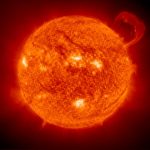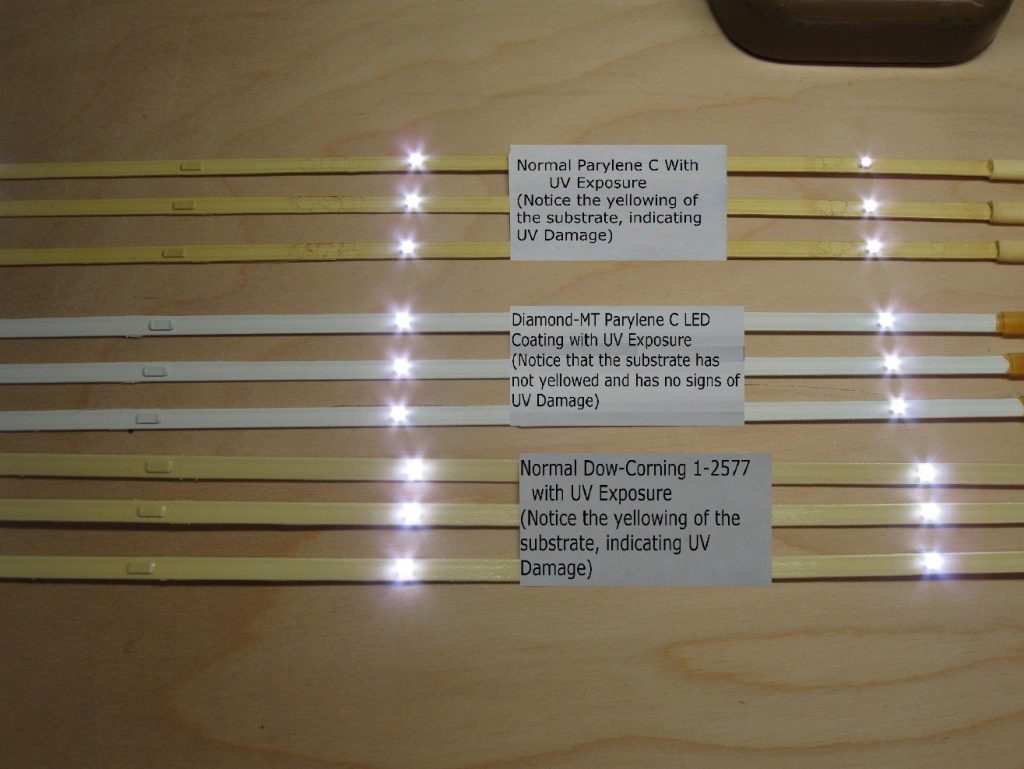Parylene Conformal Coatings and UV Light
Posted by Sean Horn
Friday, February 5, 2016 7:54
@ 7:54 AM
Parylene has numerous outdoor applications. However, a major drawback of most parylene types is limited resistance to direct contact with UV radiation. Daylight is the most common source of UV light. Prolonged exposure to its high energy radiation can cause objects extensive surface damage and lead to eventual malfunction of electrical light-generating assemblies within.
This is a significant drawback, since the objective of conformal coatings is the sustain assembly function in the long term. Generally fine when not directly exposed to UV — as in the many cases where components are internally situated within a product – most generally transparent parylene films yellow and degrade from prolonged contact with sunlight.
Limited UV Protection Provided by Most Parylenes
 This is not the case for all types of radiation, where parylene’s coating properties are maintained. For instance, in a vacuum, parylene’s radiation resistance to gamma ray degradation is consistently impressive. Conformal films composed from parylene for types C, D, N. and AF-4 retain electrical and tensile properties at dosages of 1,000 kilograys (kGy), through a dose rate of 16 kGy/hr. However, outside a vacuum and exposed to air, rapid embrittlement develops. Nevertheless, the mentioned parylene types do generate rather reliable gamma ray protection in a vacuum.
This is not the case for all types of radiation, where parylene’s coating properties are maintained. For instance, in a vacuum, parylene’s radiation resistance to gamma ray degradation is consistently impressive. Conformal films composed from parylene for types C, D, N. and AF-4 retain electrical and tensile properties at dosages of 1,000 kilograys (kGy), through a dose rate of 16 kGy/hr. However, outside a vacuum and exposed to air, rapid embrittlement develops. Nevertheless, the mentioned parylene types do generate rather reliable gamma ray protection in a vacuum.
The same cannot be said for exposure to UV light (direct sunlight). Much has to do with the substances’ chemical composition:
- Parylene N is an unsubstituted hydrocarbon molecule.
- Parylene C has one added chlorine group per repeat unit.
- Parylene D has two added chlorine groups per repeat unit.
- In contrast, parylene AF-4 replaces the hydrogen atoms on the chemical’s benzene ring with fluorine atoms, significantly enhancing its UV-stability.
Diverse UV Protection, According to Parylene Properties
Basically hydrocarbon dimers, parylene types have different properties. Although it has the best surface-permeating capacities of the parylenes, type N is especially susceptible to UV-generated damage. It has a significantly higher oxygen permeability than parylene C, whose composition has an added chlorine atom; Parylene D adds a second chlorine atom. Nevertheless, the superior impermeability of types C and D declines markedly with UV exposure. Oxygen in UV light causes their coating to decompose into aldehydes and carboxylic acids near the conformal film’s surface, yellowing them and reducing their barrier protection, endangering component function.
Parylene AF-4
Parylene AF-4 is the only parylene type that displays a consistent degree of UV-resistance, one wherein performance is maintained relatively long-term. Like the other parylene types, AF-4 also forms an effective, structurally continuous protective film as thin as several hundred angstroms, due to uniqueness of the chemical vapor deposition (CVD) process used to coat substrate surfaces.
Also called aliphatic fluorinate, AF-4 replaces the alpha hydrogen atom of the N dimer with fluorine, and totals 4 atoms. This compositional variation allows AF-4 to generate the lowest parylene coefficient of friction and dielectric constant throughout UV-exposure, and the highest penetrating ability. AF-4 is also useful in high temperature, short-term applications up to 450°C.
Thus, while parylenes C, D, and N provide dependably stable conformal coatings indoors, degradation commences shortly after exposure to UV light. Only parylene AF-4 displays longer-term and consistent resistance to UV light, for wavelengths between 272 – 400 nm; component degradation is eliminated even after 2,000 hours in air. However, AF-4 is the most expensive of the parylenes, with costs between $8,000 and $10,000 per kilogram. Processing for AF-4 adds a necessary third-step to the synthesis of its precursor, generating only low yield and a reduced deposition efficiency during production, driving total costs higher. Less expensive at this stage may be using another substance – acrylic or silicone, for example — to provide UV-resistance to parylene-coated assembles exposed to UV light.
Table 1 compares the spectra of parylene types C, D, N, and AF-4 to UV light.
Table 1: Ultraviolet Spectra of Parylenes D. C. N. and AF-4
| Parylene Type | % Transmittance | Wavelength, nm |
| D, Lower range
Mid-range Upper range |
0
75 90 |
290
350 398 |
| C, Lower range
Mid-range Upper range |
0
68 74 |
277
348 395 |
| N, Lower range
Mid-range Upper range |
0
81 88 |
279
349 397 |
| AF-4, Lower range
Mid-range Upper range |
0
90 91 |
272
351 400 |
Diamond-MT has developed a process in which typical parylene C or N can offer UV stability along with the great protection of parylene.

We verified our process with some accelerated UV testing. The results of the UV test of 504 hours accelerated testing with UVB 313 nm cycling between 8 hours UV at 60 degree Celsius and 8 hours condensation at 50 degree Celsius showed that all board substrates survived the test. Normal parylene C and Dow Corning 1-2577 exhibited a fair amount of UV damage, as evidenced by the significant yellowing. Using Diamond-MT’s process prevented the UV damage and is considered the best option.
Summary
This evidence suggests AF-4’s superior coating and resistant qualities for UV uses, throughout the widest UV-wavelength range. The parylene types N, D and C can provide much shorter-term UV protection when treated externally with other coating substances, such as acrylic or silicone; however, even under these conditions UV-protection is limited.
In contrast, AF-4 provides 2,000 or more hours of UV-usage without suffering decomposition or surface yellowing. Moreover, AF-4 is effective with a much thinner protective coating layer. Applied as external coatings to other parylene types, substances like or acrylic or silicone need to be deposited in much thicker layers, severely restricting their applications for the microelectricalmechanical (MEMS) and nano-systems’ functionality rapidly becoming more prominent for most digital assemblies and components. Under these conditions, the prospect of item malfunction or breakdown can actually make AF-4 parylene more economical to use in the long run.
To learn more about parylene and UV light, download our whitepaper:
{{cta(‘ef898c1a-336f-453d-a25a-9bea322a2113’)}}
Comments
Homepage 4/17/2020. 10:17:10 AM
... [Trackback] [...] Informations on that Topic: blog.paryleneconformalcoating.com/whats-the-difference-between-potting-and-conformal-coating/ [...]

londondrugscanada.bigcartel.comlondon-drugs 4/17/2020. 10:17:10 AM
cialis uk https://londondrugscanada.bigcartel.com/london-drugs This is nicely expressed. !